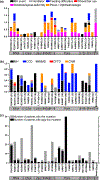Intracellular calcium leak as a therapeutic target for RYR1-related myopathies
- PMID: 32236737
- PMCID: PMC7788518
- DOI: 10.1007/s00401-020-02150-w
Intracellular calcium leak as a therapeutic target for RYR1-related myopathies
Abstract
RYR1 encodes the type 1 ryanodine receptor, an intracellular calcium release channel (RyR1) on the skeletal muscle sarcoplasmic reticulum (SR). Pathogenic RYR1 variations can destabilize RyR1 leading to calcium leak causing oxidative overload and myopathy. However, the effect of RyR1 leak has not been established in individuals with RYR1-related myopathies (RYR1-RM), a broad spectrum of rare neuromuscular disorders. We sought to determine whether RYR1-RM affected individuals exhibit pathologic, leaky RyR1 and whether variant location in the channel structure can predict pathogenicity. Skeletal muscle biopsies were obtained from 17 individuals with RYR1-RM. Mutant RyR1 from these individuals exhibited pathologic SR calcium leak and increased activity of calcium-activated proteases. The increased calcium leak and protease activity were normalized by ex-vivo treatment with S107, a RyR stabilizing Rycal molecule. Using the cryo-EM structure of RyR1 and a new dataset of > 2200 suspected RYR1-RM affected individuals we developed a method for assigning pathogenicity probabilities to RYR1 variants based on 3D co-localization of known pathogenic variants. This study provides the rationale for a clinical trial testing Rycals in RYR1-RM affected individuals and introduces a predictive tool for investigating the pathogenicity of RYR1 variants of uncertain significance.
Keywords: Calcium; Central core disease; Genetics; RyR1-related myopathy; Ryanodine receptor; Therapeutics.
Conflict of interest statement
Figures







References
Publication types
MeSH terms
Substances
Grants and funding
- R01 HL061503/HL/NHLBI NIH HHS/United States
- R25NS076445/NH/NIH HHS/United States
- T32 HL120826/HL/NHLBI NIH HHS/United States
- R01DK118240/NH/NIH HHS/United States
- R01AR070194/NH/NIH HHS/United States
- R01HL061503/NH/NIH HHS/United States
- R01 DK118240/DK/NIDDK NIH HHS/United States
- R01HL142903/NH/NIH HHS/United States
- R01HL140934/NH/NIH HHS/United States
- UL1 TR001873/TR/NCATS NIH HHS/United States
- R25 NS076445/NS/NINDS NIH HHS/United States
- T32HL120826/NH/NIH HHS/United States
- R01 HL145473/HL/NHLBI NIH HHS/United States
- R01 HL142903/HL/NHLBI NIH HHS/United States
- R01 HL140934/HL/NHLBI NIH HHS/United States
- R01HL145473/NH/NIH HHS/United States
- UL1TR001873/NH/NIH HHS/United States
LinkOut - more resources
Full Text Sources
Other Literature Sources
Medical
Research Materials

